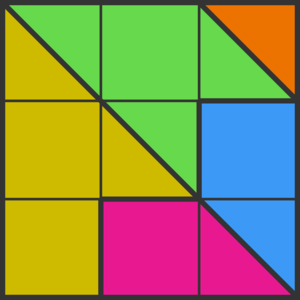Squaring Pi
Can the π figure above, composed of 5 pieces of different colors, be rearranged into a perfect square?
The individual pieces can be rotated, reflected and translated.
This section requires Javascript.
You are seeing this because something didn't load right. We suggest you, (a) try
refreshing the page, (b) enabling javascript if it is disabled on your browser and,
finally, (c)
loading the
non-javascript version of this page
. We're sorry about the hassle.
3 solutions
how do you guys make these pictures?
As far as I can determine, that is the unique solution (up to rotation / reflection).
Do you see another way?
Log in to reply
If you allow for flipping the pieces upside-down, then this results in distinct solutions.
 Blue and Green pieces flipped upside-down
Blue and Green pieces flipped upside-down
You can also switch the pink and blue pieces, since they are identical through rotation.
Log in to reply
Yes, I too would like to know how these images are made.
Log in to reply
@Jesse Nieminen – @Jesse Nieminen - The images are made on figma. Your welcome.
That's interesting. here is a discussion that is sort of related.
Is in the question implicit that it has to be composed of 5 colors all the same? I don't think so, either way the answer is "yes".
The black lines mean nothing other than the size of the objects I believe. I don't think this proves anything as the ability to put the colored pieces together is dependent on shape also.
If two collections of pieces have the same area, it doesn't mean that the other one can be constructed by rearranging the pieces of the first one. Hence, your solution is invalid.
It is a necessary condition of course, but it is not sufficient!
this doesn't prove it can be a square.....
What Andrew said.
You may have noticed that if you remove the very edges of the pi symbol, you have a perfect square left over (minus the two edges of course). Transfer those two edge squares to the empty space and you have your completed perfect square.
A possible solution is below: